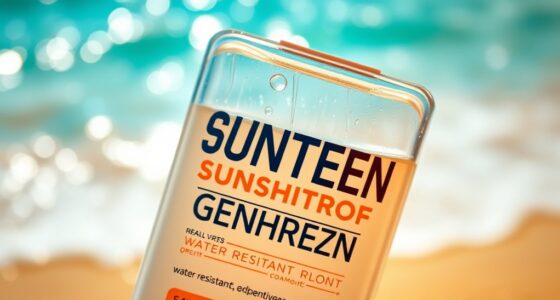You can protect your skin while enjoying the outdoors by applying broad-spectrum sunscreen with at least SPF 30. Make sure you cover all exposed areas, including your face, neck, and hands. Reapply every two hours, especially if you're sweating or swimming. Wearing protective clothing, like long sleeves and wide-brimmed hats, can shield you from direct sunlight. Try to plan outdoor activities early in the morning or late in the afternoon when UV rays are less intense. Staying hydrated and maintaining a good skincare routine will also help. Stick around to discover more essential tips for safeguarding your skin.
Key Takeaways
- Apply broad-spectrum sunscreen with SPF 30 or higher on all exposed skin, including face, neck, and hands, even on cloudy days.
- Wear UPF-rated clothing and wide-brimmed hats to provide additional protection from harmful UV rays while enjoying outdoor activities.
- Schedule outdoor activities for early morning or late afternoon to minimize exposure during peak UV radiation hours.
- Seek shade whenever possible, especially between 10 AM and 4 PM, to reduce direct sun exposure.
Importance of Sun Protection
Protecting your skin from the sun is essential, as daily use of broad-spectrum sunscreen can greatly reduce your risk of skin cancer and premature aging.
UV rays are present even on cloudy days and can penetrate through windows, meaning you need to apply sunscreen indoors too. You're not just protecting yourself during outdoor activities; every moment spent near a window can expose your skin to harmful UVA rays.
Remember, these rays contribute to skin damage and hyperpigmentation, so don't skip sunscreen even if you think you're safe inside. It's important to apply sunscreen with an SPF of 30 or higher to all exposed areas, including your face, neck, and hands.
Prolonged and cumulative exposure to UV rays, including incidental exposure during your daily commute, adds up over time. Over time, this can lead to significant skin issues, making consistent sun protection essential.
Dermatologists emphasize that sunscreen should be part of your everyday skincare routine, regardless of the weather. By taking these precautions, you can effectively protect your skin and maintain its health for years to come.
Choosing the Right Sunscreen

When you're picking a sunscreen, it's essential to understand the different types available and how to apply them effectively.
You want to make certain you're protected from both UVA and UVB rays while applying it correctly for maximum benefit.
Let's break down the options and tips to keep your skin safe outdoors.
Types of Sunscreens Explained
Choosing the right sunscreen involves understanding the differences between mineral, chemical, and hybrid formulas to find what works best for your skin.
Mineral sunscreens contain physical blockers like titanium dioxide and zinc oxide, which sit on your skin's surface to reflect UV rays. They're ideal if you have sensitive skin.
On the other hand, chemical sunscreens absorb UV radiation through their ingredients, converting it to heat and releasing it from your skin. While they're often less visible, they may irritate some skin types.
Hybrid sunscreens merge the benefits of both mineral and chemical filters, offering broad-spectrum protection while catering to various preferences for texture and finish.
When shopping for sunscreen, aim for a broad-spectrum formula with an SPF rating of 30 or higher. This guarantees you're protected against both UVA and UVB rays, vital for preventing skin damage and cancer.
If you find yourself indoors often, consider sunscreens with hydrating ingredients like ceramides or hyaluronic acid. These not only protect your skin from UV damage but also help maintain moisture in dry environments.
Application Tips for Effectiveness
Applying sunscreen correctly is vital to guarantee you get the maximum protection your skin needs from harmful UV rays. When choosing sunscreen, always pick a broad-spectrum formula with an SPF of 30 or higher. This guarantees you protect against UVA and UVB rays effectively. If you have sensitive skin, consider mineral sunscreens containing zinc oxide or titanium dioxide, which offer a physical barrier.
To keep your skin hydrated, look for sunscreens with added ingredients like ceramides and hyaluronic acid. Remember, applying the right amount is vital. Use about a nickel-sized amount for your face and roughly one shot glass full for your entire body.
Here's a quick reference table for effective sunscreen application:
| Amount Needed | Area to Cover | Frequency of Application |
|---|---|---|
| Nickel-sized amount | Face | Every 2 hours |
| Shot glass full | Entire body | Every 2 hours |
| Reapply after sweating | Any exposed skin | After swimming/sweating |
Effective Application Techniques

When it comes to sunscreen, how you apply it can make all the difference.
You need to use enough product and reapply it regularly to keep your skin protected from harmful UV rays.
Let's explore the best techniques to guarantee you're getting the most out of your sunscreen.
Proper Sunscreen Application
A nickel-sized amount of sunscreen is all you need to thoroughly cover your face and protect those often-neglected areas like your neck, ears, and hands.
Make sure to choose a broad-spectrum sunscreen with an SPF of 30 or higher, as this defends against both UVA and UVB rays, essential for your skin care routine.
Before heading outdoors, apply the sunscreen at least 15 minutes prior to sun exposure. This allows the product to absorb properly into your skin, offering maximum protection against harmful UV rays.
Don't forget to rub it in well, ensuring even coverage on all exposed areas.
Remember, the skin on your neck, ears, and hands can easily be overlooked, yet these areas are just as susceptible to sun damage. So, give them the attention they deserve.
Incorporating sunscreen into your daily skin care routine can be simple; consider using a moisturizer that contains sunscreen. This not only hydrates your skin but also makes application easier, especially for those who spend time around indoor light sources.
Protect your skin effectively, and enjoy your time outdoors!
Reapplication Frequency Essentials
To keep your skin protected while enjoying the outdoors, reapply sunscreen every two hours, or more often if you're swimming or sweating. This is vital for maintaining effective protection against UV exposure, which can lead to skin damage.
Use about one ounce of sunscreen, roughly the size of a shot glass, to guarantee full body coverage. For your face, aim for a nickel-sized amount, applying it evenly to avoid missed spots.
If you're on-the-go or wearing makeup, consider using a spray or powder sunscreen for convenient reapplication. Just make certain it's labeled as Broad Spectrum with at least Sunscreen SPF 30 to shield against both UVA and UVB rays.
Always check the expiration date of your sunscreen before heading out. Expired products may not provide the necessary protection you need. Store your sunscreen in a cool, dry place to maintain its efficacy.
Protective Clothing Options

Protective clothing options, like tightly woven fabrics and UPF-rated garments, play an essential role in shielding your skin from harmful UV rays while enjoying the outdoors. To maximize your skin protection, consider incorporating the following items into your wardrobe:
| Clothing Type | Benefits |
|---|---|
| Long-sleeved shirts | Blocks significant UV rays |
| Wide-brimmed hats | Protects face and neck |
| Full-length pants | Minimizes leg exposure |
When selecting UPF clothing, look for ratings between UPF 30 and UPF 50+ for ideal protection. Tightly woven fabrics like denim or canvas can block over 90% of UV rays, making them great choices for outdoor activities. Additionally, lightweight, breathable fabrics treated with UV-blocking agents are perfect for hot weather, ensuring comfort without sacrificing skin protection.
Darker colors enhance UV protection by absorbing more radiation, so don't shy away from deeper hues. By opting for these protective clothing options, you can enjoy the sunny outdoors while keeping your skin safe from damaging UV rays.
Timing Your Outdoor Activities

Planning your outdoor activities around the sun's intensity can greatly reduce your risk of UV exposure. Aim for early morning or late afternoon outings, ideally before 10 a.m. or after 4 p.m. This timing helps you dodge the harshest UV radiation, which peaks between 10 a.m. and 4 p.m.
To visualize your ideal outdoor schedule, consider these moments:
- Morning jogs while the dew is still fresh and the sun is gentle.
- Afternoon picnics under the soft glow of the setting sun.
Even on cloudy days, up to 80% of UV rays can still reach your skin, so don't skip applying sunscreen. Regularly check the UV index to better plan your activities and minimize skin damage.
If you're out for extended periods, remember to take breaks in shaded areas to help your skin recover. By timing your outdoor activities wisely, you can enjoy the beauty of nature while protecting your skin.
Seeking Shade and Shelter

Finding shade during peak sun hours is a simple yet effective way to shield your skin from harmful UV rays while enjoying the great outdoors. Typically, you should aim to seek shade between 10 AM and 4 PM, when UV exposure is at its highest. Natural shade from trees or portable structures can block up to 50% of UV rays, giving you a cooler spot to relax.
| Type of Shade | UV Protection Level | Best Use |
|---|---|---|
| Natural Trees | Up to 50% | Parks, beaches, forests |
| Umbrellas/Canopies | Moderate | Patios, picnics |
| UV-Protective Tents | High (98%) | Beaches, outdoor events |
| Clothing/Hats | Up to 98% | Anytime outdoors |
To enhance your skin protection further, consider wearing UV-protective clothing and hats. Also, keep an eye on the UV index, as it helps you determine the best times to be outdoors and when to prioritize seeking shade. By being mindful of these strategies, you can enjoy your time outside while keeping your skin safe.
Hydration and Skin Care

Staying hydrated is vital for keeping your skin healthy and elastic, especially when spending time outdoors. Drinking at least 8 glasses of water daily helps maintain skin elasticity and combats dryness.
To enhance your hydration efforts, consider integrating these key elements into your skincare routine:
- Hyaluronic acid for plumping and retaining moisture.
- Glycerin to draw moisture from the air, keeping your skin supple.
Regularly applying a moisturizer after cleansing locks in hydration and protects your skin's barrier, which is important in dry indoor environments.
If you find yourself inside, using a humidifier can combat the drying effects of indoor heating, maintaining balanced moisture both in the air and on your skin.
Remember, your skincare routine should include these hydrating practices not just outdoors but also at home to guarantee your skin stays nourished and vibrant.
Embrace these tips, and your skin will thank you for the extra care, looking fresh and resilient, no matter where you are.
Managing Breakouts Outdoors

While hydration plays a key role in maintaining healthy skin, managing breakouts outdoors requires specific strategies to keep your complexion clear and radiant.
Start by applying a non-comedogenic sunscreen with SPF 30 or higher. This protects your skin from UV rays that can exacerbate acne and irritation.
Before you head outdoors, wash your face with a gentle cleanser to remove sweat and dirt that can clog pores. After your activities, cleanse again to eliminate any irritants that may have accumulated.
Incorporate products with salicylic acid or benzoyl peroxide into your skincare routine, as they can effectively prevent and treat breakouts triggered by outdoor conditions.
Staying hydrated is essential, too. Drink plenty of water to maintain oil production balance and reduce the likelihood of acne flare-ups.
Additionally, consider wearing breathable, UV-protective clothing to minimize friction and irritation on your skin while also blocking harmful UV rays.
Understanding UV Exposure

You might think you're safe indoors, but UVA rays can still reach you through windows, exposing your skin to potential damage.
Plus, the blue light from your screens can contribute to premature aging, so it's important to protect your skin even when you're inside.
Understanding the cumulative effects of UV exposure is vital for maintaining healthy skin, no matter where you are.
Indoor UV Risks
Indoor environments can still pose significant UV risks, as UVA rays penetrate glass and contribute to skin aging and cancer risk. Many people mistakenly believe that staying indoors protects them from harmful UV rays, but studies show that up to 50% of UVA rays can reach your skin through windows. This makes it essential to incorporate sunscreen into your daily routine, even when you're inside.
Consider this:
- Sitting by a window, you may unknowingly expose yourself to harmful rays.
- Commuting in your car, the left side of your face could receive significant sun damage.
Dermatologists recommend applying a broad-spectrum sunscreen daily, regardless of your plans. Remember, cumulative UV exposure can lead to long-term skin damage, so don't skip this important step.
Make it a habit to protect your skin while indoors, ensuring you safeguard your health just as diligently as you'd outside. Prioritize your skin's well-being and enjoy every moment, no matter where you are!
Blue Light Effects
Blue light exposure from digital devices and sunlight can greatly impact your skin, leading to premature aging and other issues. You might be surprised to learn that blue light affects your skin's health just as much as UV rays do. While it doesn't cause immediate damage like UVB rays, prolonged exposure can lead to oxidative stress, which contributes to skin aging and hyperpigmentation over time.
If you spend hours in front of screens or enjoy outdoor activities, you need to wear sunscreen that also protects against blue light. Look for products containing ingredients like iron oxide, which can effectively shield your skin from this type of light. Research shows that blue light can exacerbate existing skin conditions, such as acne and melasma, by stimulating melanin production.
Moreover, blue light exposure can disrupt your skin barrier, leading to increased moisture loss and dryness. To maintain healthy skin, it's crucial to incorporate protective skincare products into your routine. By being proactive about blue light protection, you'll help minimize the risk of premature skin aging and keep your complexion looking vibrant and youthful.
Cumulative Exposure Awareness
Understanding cumulative UV exposure is vital, as even brief moments in the sun can accumulate and lead to significant skin damage over time. You might think a quick stroll or a few minutes in your car won't hurt, but those moments add up.
- Sitting by the window, sunlight streaming in, unknowingly exposing your skin to harmful UVA rays.
- Enjoying a picnic, forgetting to reapply sunscreen while laughter fills the air.
Cumulative exposure awareness is important for protecting your skin. UVA rays can penetrate glass, meaning you need to wear sunscreen even indoors.
Both UVA and UVB rays are harmful, with UVB causing sunburn and skin cancer, while UVA contributes to long-term aging and hyperpigmentation.
Expert Tips for Skin Health

To keep your skin healthy, consistently apply broad-spectrum sunscreen with at least SPF 30, even when you're inside. A board-certified dermatologist emphasizes that UVB rays can penetrate windows, so daily protection is essential.
Alongside sunscreen, establish a solid skin-care routine that includes cleansing, moisturizing, and regular exfoliation. This will help combat the effects of indoor environments on your skin.
Incorporate antioxidants into your routine to fight oxidative stress caused by indoor pollutants and blue light from screens. These can promote overall skin health and reduce the risk of pigmentation changes.
Additionally, consider using blue light-blocking products or screen protectors to minimize potential skin damage.
Don't forget about hydration; using a humidifier helps counteract the drying effects of indoor heating. Keeping your skin hydrated prevents irritation and maintains its natural barrier.
Finally, remember that taking care of your skin also positively impacts your mental health. When you feel good about your skin, it boosts your confidence and wellbeing.
Frequently Asked Questions
How Bad Is It to Skip Sunscreen if I'm Staying Inside All Day?
Skipping sunscreen while staying inside isn't as safe as you think. UVA rays can still harm your skin through windows, and blue light from screens can worsen skin issues. Always apply broad-spectrum sunscreen, even indoors.
What Effects Does Staying Indoors Have on the Skin?
Imagine feeling your skin becoming dull and lifeless after weeks indoors. Staying inside can lead to uneven tone, dryness, and irritation from dust. Your skin thrives on fresh air and natural sunlight for energy.
How Can I Protect My Skin Indoors?
To protect your skin indoors, apply broad-spectrum sunscreen daily, incorporate antioxidants, and maintain a consistent cleansing and moisturizing routine. Don't forget to clean surfaces regularly to minimize bacteria that can irritate your skin.
Can Staying Indoors Make Your Skin Dry?
Staying indoors can feel like wrapping your skin in a desert's embrace, leaving it parched and craving moisture. Yes, extended indoor time can definitely dry your skin, making hydration essential to restore its natural glow.
How Does Hydration Help in Protecting Your Skin From Sun Damage?
Healthy skin hydration tips are essential to protect your skin from sun damage. Staying hydrated helps maintain your skin’s elasticity and prevents it from becoming dry and prone to damage. Drinking enough water and using hydrating skincare products are crucial for keeping your skin healthy and protected from the sun’s harmful effects.
Conclusion
In the same way a gardener nurtures plants with just the right amount of sunlight and shade, you can cultivate your skin's health by balancing sun exposure with protection.
With the right sunscreen, protective clothing, and smart timing, you can enjoy the outdoors without sacrificing your skin's well-being.
Think of each outing as a chance to tend to your skin's garden—water it with hydration, shield it from harsh rays, and watch it thrive.









